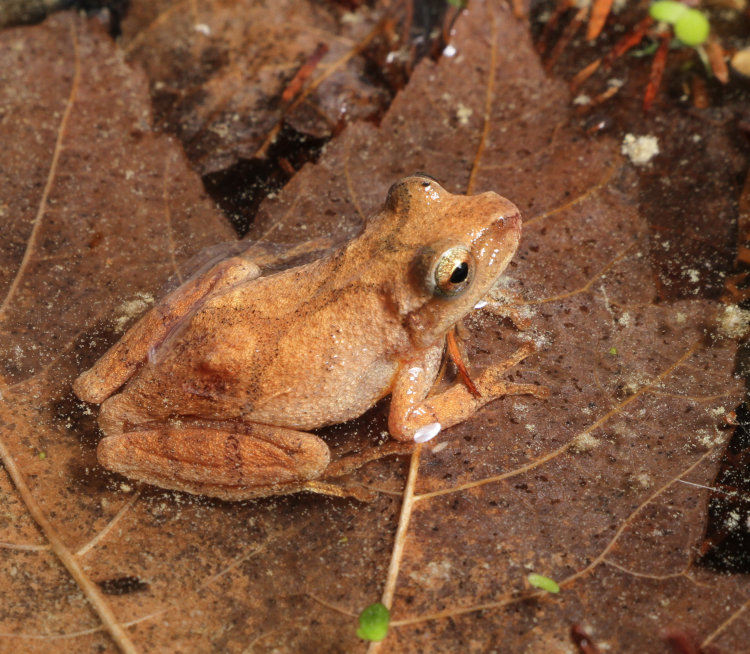The other night as I worked on the computer in Deep 13 (my basement office/workshop/studio/makerspace/junk room,) I heard a soft, repeated sound, kind of a cross between a tap and a thump, coming from someplace off behind me. Once the repetition had established itself, I got up and went looking for it. It didn’t take very long.

This is a spring peeper (Pseudacris crucifer,) one of the most common chorus frogs, and no, my office is not this flooded – this is a small homemade studio setting that I created just to get detail images. The frog had two potential means of ingress: I had a ground-level window cracked in the attached utility closet for ventilation, the most likely access, but I’d also had the outside door open for a few hours in the afternoon because it was that nice out. Given that these guys get active at night, I’m leaning towards the former, even though the space it would have had to slip through past the ventilation unit was quite small – so are these, this specimen being perhaps 12mm in length.

This image shows where it gets part of its scientific name, the ‘crucifer’ bit – it’s that ‘X’ or cross on the back, and I like how the pattern continues onto the hind legs when they’re tucked in typical fashion, like the coloration was applied afterwards. Such patterns serve to break up the froggy outline and make them harder to spot, but why an ‘X’? I don’t know, and can’t right offhand think of anything in their preferred boggy environments that looks like that. It’s likely just a happenstance thing, a semi-random pattern to blend in with the water-borne debris, repeated through bilateral symmetry. This is an exceedingly common trait: details on the left side of the vast majority of organisms are repeated on the right, with very few examples of true randomness. It’s just how the genes develop.

Meanwhile, we see here a small artifact of the peepers’ (and many frogs’) behavioral traits. They often leap quite blindly, mostly determining that the way ahead is open and little else, and this one was banging its snout on both the office steps (the noise that attracted my attention) and immediately after capture, the small terrarium that I held it in while I created this elaborate setting. It’s just a little inflammation/bruising – remember that this guy is the size of the top joint of my thumb.
I’ve already featured their calls, but we’ll hear them again:
Several amphibian species
All of the high-pitched ‘cheeps’ or squeaks in there are spring peepers – they’re very common. What I find curious is that, back where we used to live, the frogs and toads seemed to give up on calling after a few hours, certainly by midnight, but here they appear to keep sounding off all night long, when the weather’s right at least.
But while I’m here, I feature a frame from yesterday:

Resist the urge to think this is a mother and offspring, if you’re still so inclined: these are two different species, and most amphibians don’t care for their young in any manner. The one on top is an eastern painted turtle (Chrysemys picta picta,) albeit probably only a few years old, while the other is a yellow-bellied slider (Trachemys scripta scripta,) certainly much older, though I have no idea how long it takes them to get to this size. The carapace of the painted turtle would probably have spanned slightly larger than my palm, while the slider likely weighed a few kilograms. I spotted this from a notable distance, confirming that they really were stacked only through the use of the long lens, and slowly crept closer to get a better view. Soon after this shot, they considered me to be too close and slid off into the water. But yeah, I doubt the slider was ever in a better position for the painted to access, so the little one likely had a significant climb up that domed shell. All in the name of getting some solar radiation.



















































